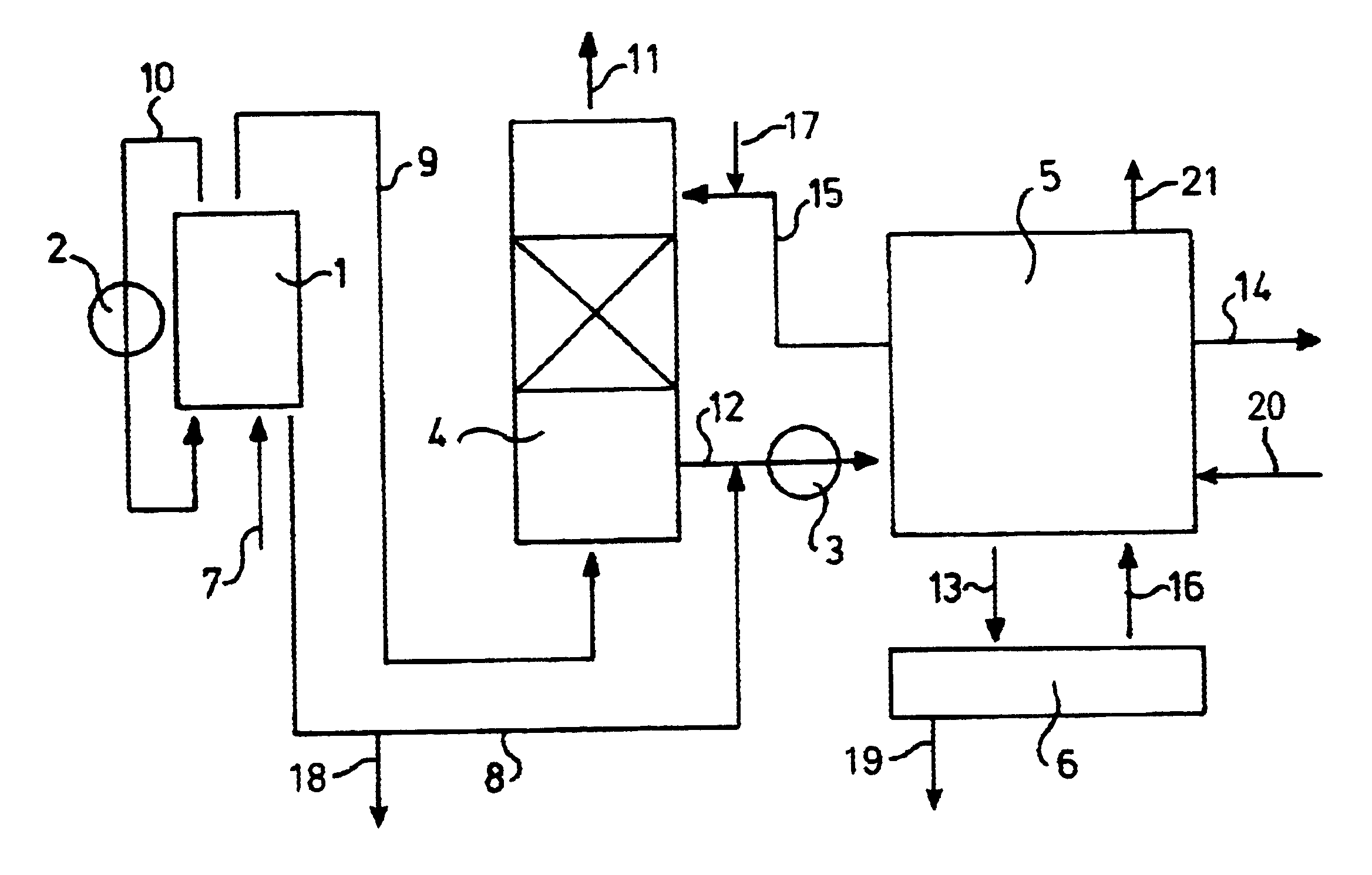Method for desulphurization of gases
a technology of desulphurization and gas, which is applied in the direction of biological water/sewage treatment, sulfur preparation/purification, separation processes, etc., can solve the problems that the catalytic reduction step cannot be recycled to the claus reactor, and achieve the effect of preventing excessive uptake, reducing the need for make-up water, and reducing the effect of was
- Summary
- Abstract
- Description
- Claims
- Application Information
AI Technical Summary
Benefits of technology
Problems solved by technology
Method used
Image
Examples
example 1
Claus Off-gas
After catalytic conversion, Claus off-gas (20,000 m.sup.3 (s.t.p.) / h) has a temperature of 200.degree. C. About 4 tonnes of sulphur are removed as H.sub.2 S each day. The hot gas contains 33 vol% of water vapour. In the Thiopaq reactor, 25 kg of SO.sub.4 / h is formed, based on 5% oxidation to the highest state. With a standard sulphate concentration in the bioreactor of 18 kg of SO.sub.4 / m.sup.3, the discharge stream will be 1.4 m.sup.3 / h. Cooling the gas to 63.degree. C. will produce the same amount of condensate water. Cooling is effected as follows: by means of a quench, the gas is cooled to its dew point of about 70.degree. C. The biological system is operated at 50.degree. C., thus causing the temperature of the gas in the absorber to drop to 63.degree. C. The scrub water used will warm up in the process, which means that a heat exchanger will be required.
example 2
After catalytic conversion, syngas has a temperature of 160.degree. C. and a flow rate of 6000 m.sup.3 (s.t.p.) / h. About 4 tonnes of S are removed as H.sub.2 S each day. The gas contains 30 vol% of water vapour.
Maintaining the conductivity at the desired level requires a discharge stream of 1.4 m.sup.3 / h. Because the amount of gas is much lower than in the previous example, cooling of the gas takes place directly in the absorber. Cooling the gas to 56.degree. C. causes condensation of enough water vapour to obtain the desired discharge stream. Cooling is achieved by the biological system being operated at 48.degree. C. The heated scrub water is cooled by means of a heat exchanger.
example 3
An amount of gas (31,574 m.sup.3 (s.t.p.) / h) from a hydrogenation reactor has the following composition:
1.24 vol% of H.sub.2 S
2.02 vol% of H.sub.2
12.64 vol% of CO.sub.2
56.65 vol% of N.sub.2
0.67 vol% of Ar
26.80 vol% of H.sub.2 O
The temperature is 317.degree. C. and the pressure is 1.10 bar (abs).
If this gas is cooled to 32.degree. C., the water content drops to 4.55 vol %. This means that 5.89 m.sup.3 / h of water will condense. If 3.5% of the captured H.sub.2 S oxidizes to a sulphate, 57 kg / h of sulphate are formed. For a sulphate content of 25 kg / M.sup.3, the discharge stream will be 2.3 m.sup.3 / h. The net production of water which can be used for other purposes is 3.59 m.sup.3 / h.
PUM
| Property | Measurement | Unit |
|---|---|---|
| Angle | aaaaa | aaaaa |
| Temperature | aaaaa | aaaaa |
| Electrical conductivity | aaaaa | aaaaa |
Abstract
Description
Claims
Application Information
 Login to View More
Login to View More - R&D
- Intellectual Property
- Life Sciences
- Materials
- Tech Scout
- Unparalleled Data Quality
- Higher Quality Content
- 60% Fewer Hallucinations
Browse by: Latest US Patents, China's latest patents, Technical Efficacy Thesaurus, Application Domain, Technology Topic, Popular Technical Reports.
© 2025 PatSnap. All rights reserved.Legal|Privacy policy|Modern Slavery Act Transparency Statement|Sitemap|About US| Contact US: help@patsnap.com


